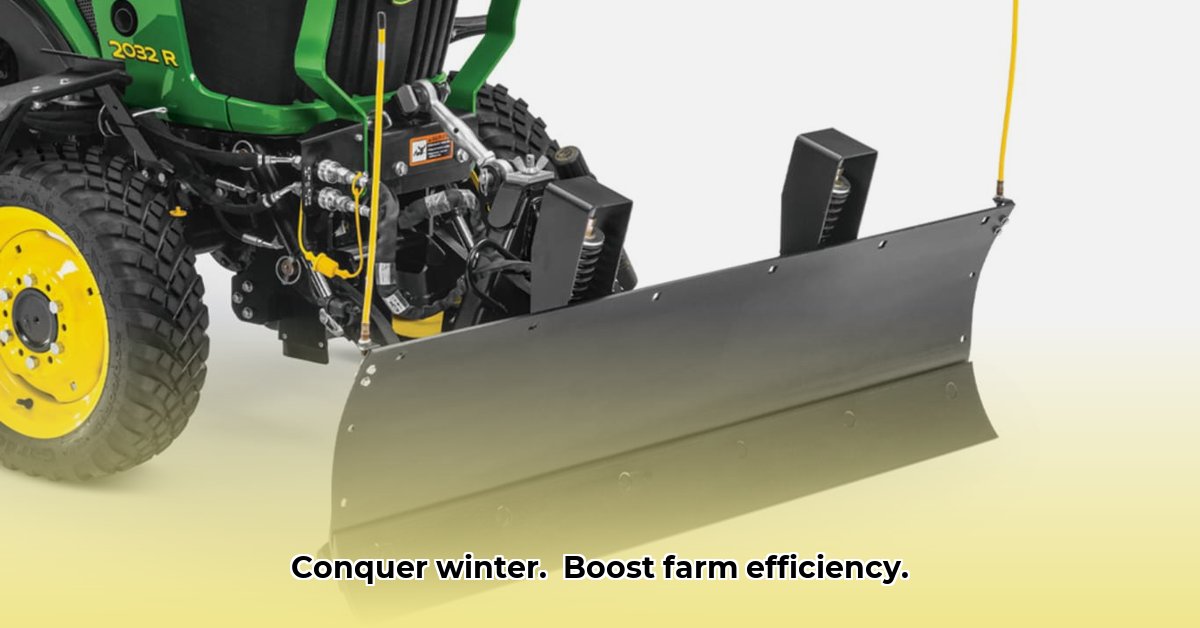
Tractor Front Snow Blades: Optimizing Winter Farm Operations
Winter's arrival often brings significant challenges to agricultural operations. Snow accumulation can disrupt schedules, impede access to fields, and even damage crops. John Deere's Frontier AF11E and AF13E tractor front snow blades offer a robust solution, enabling farmers to maintain productivity throughout the winter months. For information on rear blades, check out this helpful resource. This guide provides a comprehensive comparison of these two models, outlining their operational characteristics, performance capabilities, and environmental impacts.
Model Specifications: AF11E vs. AF13E
The choice between the AF11E and AF13E hinges on specific farm needs and available tractor power. The following table summarizes their key specifications:
| Feature | AF11E | AF13E | Notes |
|---|---|---|---|
| Blade Width | Variable (consult owner's manual) | 6-10 feet (adjustable) | Specific width depends on the model configuration. |
| Blade Material | Heavy-duty steel, reversible cutting edge | Heavy-duty steel, Tivar cutting edge | Tivar offers superior abrasion resistance compared to standard steel. |
| Hydraulic Requirements | Consult your tractor's specifications | Consult your tractor's specifications | Ensure compatibility with your tractor's hydraulic system. |
| Approximate Weight | Varies (consult owner's manual) | Varies (consult owner's manual) | Weight varies considerably depending on blade size and configuration. |
| Key Features | Reversible blade | Expandable width, inverted blade design | The inverted design improves snow flow and reduces clogging. |
The AF11E’s reversible blade doubles its lifespan, offering significant cost savings. The AF13E's adjustable width, however, allows for greater efficiency in clearing large areas.
Operational Instructions: Safe and Effective Snow Removal
Safe operation is paramount. Always consult the detailed owner's manual before operating either model.
Step 1: Secure Attachment: With the tractor parked securely and the PTO disengaged, carefully align the blade with the tractor's mounting points. Follow John Deere's instructions precisely, ensuring all connections are tight and secure.
Step 2: Hydraulic Adjustment (if applicable): Adjust the blade angle using the tractor's hydraulic controls to optimize snow removal for different conditions and terrains.
Step 3: Snow Removal: Begin slowly, gradually increasing speed as you become accustomed to the blade's handling. Overlap passes slightly for thorough clearance. Avoid sudden movements.
Step 4: Post-Operation Maintenance: Clean the blade thoroughly after each use to prevent rust and corrosion. Regular lubrication and inspections are crucial for long-term performance.
Comparative Analysis: Performance and Cost-Effectiveness
Both blades are durable and reliable, but their strengths differ. The AF11E's reversibility extends its lifespan, reducing long-term costs. The AF13E's expandable width increases efficiency, particularly for extensive snow removal. A comprehensive cost-benefit analysis, encompassing initial purchase price, fuel consumption, maintenance costs, and lifespan estimations, is critical for making an informed decision. Data gaps currently exist regarding long-term operational costs; further research in this area is recommended.
Sustainability Implications of Snow Removal
Efficient snow removal directly influences environmental sustainability. Minimizing passes with the blade reduces fuel consumption and carbon emissions. However, excessive snow removal can lead to soil compaction, potentially impacting drainage and plant health. Careful operation and minimizing the number of passes are crucial to mitigate this risk. The long lifespan of John Deere snow blades contributes to reducing waste from frequent equipment replacements.
Conclusion: Selecting the Right Snow Blade for Your Farm
Choosing between the AF11E and AF13E depends on individual farm needs and budgetary constraints. Consider the size of your operation, the typical snowfall amounts, and the overall power of your tractor. Both models offer dependable solutions for maintaining farm productivity throughout the winter. However, a thorough cost-benefit analysis considering long-term maintenance and fuel consumption should inform the final purchasing decision. Further research into the long-term economic and environmental effects of both models is needed to fully address the sustainability implications.